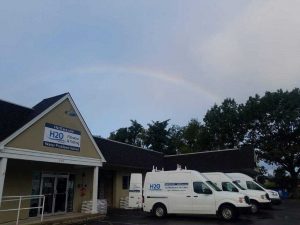
Radon in Water Solutions
Radon is a colorless, odorless, tasteless element. This makes the need for a water test of your Essex well water all the more critical. Radon is a radioactive gas which comes from the natural decay of uranium found in nearly all soils. Radon in water is not a problem until the gas escapes the water as it enters your home through faucets, showers, bathtubs and washing machines. A removal system should agitate the radon gas out of the water then vent it safely outside of your home.

Radon in Water Filtration
Contaminant Guideline Levels by State (in pCi/L as of 1/1/2019)
Rhode Island = 4,000 pico curries/liter
Maine = 4,000 ” “
Massachusetts = 10,000 ” “
New Hampshire = 2,000 ” “
HOW RADON CAN GET IN YOUR HOME OR BUSINESS
Any home may have entry points for radon. Sources may include cracks in walls. construction joints, gaps in suspended floors, gaps in service pipes, or spaces inside walls. Well water may have trapped gas which releases from the water once exiting shower heads, faucets, washing machines, etc.
RADON STUDIES, RISKS & OTHER CONCERNS
Radon is a Class A carcinogen and the second leading cause of lung cancer. The increased risk of developing lung cancer is directly related to the concentration of radon and the length of exposure to it. The U.S. Environmental Protection Agency (EPA) estimates that there are between 5,000 and 30,000 radon-related lung cancer deaths each year. Radon is the number one cause of lung cancer in non-smokers. Cigarette smokers have eight times the risk from radon as non-smokers. Therefore, cigarette smokers in particular, should keep their exposure to radon as low as possible.
POTENTIAL EXPOSURE RISKS
If the home was tested in an infrequently used basement, it may have measured a radon level that is higher than the actual level you are exposed to, spending most of your time upstairs. People with young children should be more concerned with the possible consequences of radon exposure 20 years from now than someone in their late sixties or seventies. Families with a hereditary predisposition of cancer should be more concerned about radon exposure than families who don’t have any history of cancer.
Although no level of radon in water or air is considered absolutely safe, the USEPA action level for radon is 4.0 picocuries per liter of AIR (pCi/L). (pCi/l= picocuries per liter, the most common method of reporting radon levels. A pico Curie is 0.000,000,000,001 (one-trillionth) of a Curie, an international measurement unit of radioactivity. One pCi/l means that in one liter of air there will be 2.2 radioactive disintegrations each minute. For example, at 4 pCi/l there will be approximately 12,672 radioactive disintegrations in one liter of air, during a 24-hour period.)
The risk of developing lung cancer at 4.0 pCi/L in AIR is estimated at about 7 lung cancer deaths per 1000 persons, which is why the USEPA and IEMA recommend reducing your radon level if the concentration is 4.0 pCi/L or more. For more detail on radon, see radon epa.
TESTING FOR RADON IN WATER

There can be absolutely no air bubbles in the water sample container and the sample should be tested within 24 hours of the time the sample was pulled. A water treatment professional can assist you in this process and also help you analyze the lab test results.




